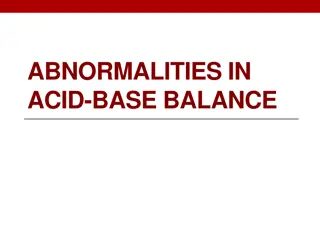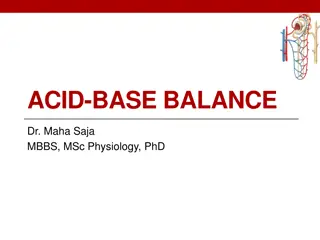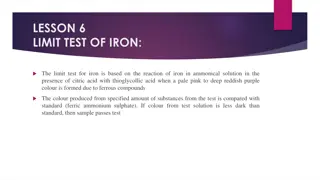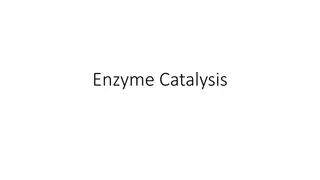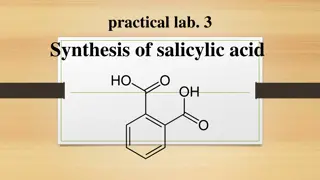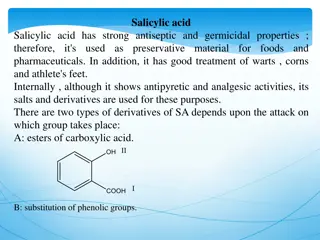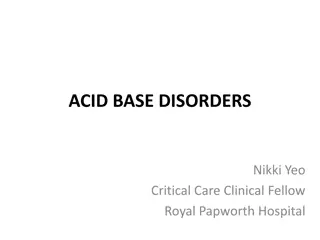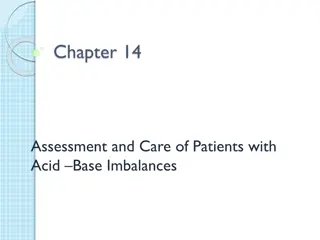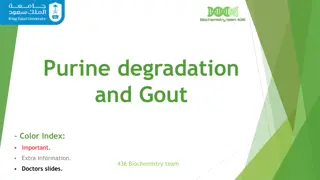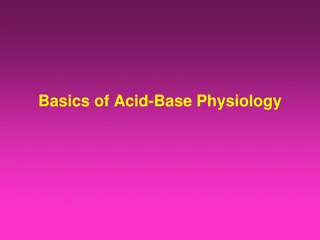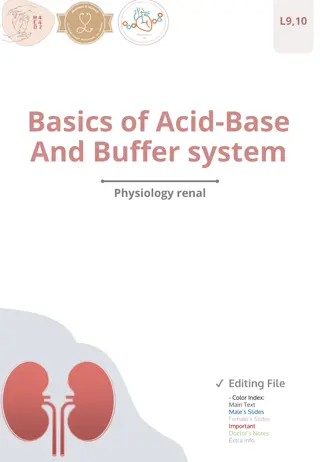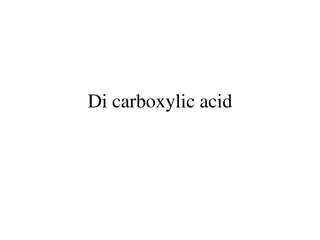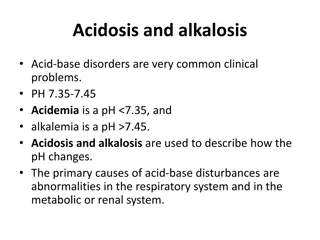Acid-Base Disturbances in Medical Practice
Explore the intricacies of acid-base physiology, mechanisms, and interpretation, along with the life-saving roles of blood buffers, respiratory reactions, and renal mechanisms. Learn how to handle acid loads and interpret abnormalities confidently, guided by expert insights.
Download Presentation

Please find below an Image/Link to download the presentation.
The content on the website is provided AS IS for your information and personal use only. It may not be sold, licensed, or shared on other websites without obtaining consent from the author.If you encounter any issues during the download, it is possible that the publisher has removed the file from their server.
You are allowed to download the files provided on this website for personal or commercial use, subject to the condition that they are used lawfully. All files are the property of their respective owners.
The content on the website is provided AS IS for your information and personal use only. It may not be sold, licensed, or shared on other websites without obtaining consent from the author.
E N D
Presentation Transcript
Introduction to Acid Base Disturbances Dr. Riyadh Al Sehli ,MBBS, FRCPC Transplant Nephrologist
Outline Components of Acid Base physiology Protective mechanisms that keep us alive How things can go wrong Acid Base interpretation with confidence Interactive cases
ACID [H] BASE [HCO3] pH pH 7.8 7.7 7.6 7.5 7.4 7.3 7.2 7.1 7.0 6.9 6.8 H 16 20 26 32 40 50 63 80 100 125 160
pK = 6.1 HCO3/H2CO3 ratio = 20/1 (26/1.3) H2CO3=0.03 PCO2 pH = pK + Log ( HCO3/H2CO3) pH = 6.1 + 1.3 pH= 7.4 * pH can never be less than 6.1
ACID Exogenous Endogenous Physiological: Diet Pathological: toxins (Methanol, Ethylene Glycol) Physiological: metabolism ( volatile & non-volatile acids) Pathological : Ketoacids and lactate
BASE HCO3 is the kidney favorite s player Liver produces HCO3 from some precursors (Lactate, Citrate)
Life saving mechanisms Blood Buffers Respiratory reaction (ventilation) Kidney reaction (metabolic)
Blood Buffers Bicarbonate-Carbonic acid system 53% Hemoglobin 35% Albumin 7% Phosphate 5% H2O + CO2 = H2CO3 = H + HCO3
Respiratory mechanism Very quick reaction PCO2 and H have a potent stimulatory effect on the respiratory centre
Renal mechanisms Increase of HCO3 Absorption Generation H acid secretion NH3 synthesis
Response to Acid load If 10 mmol/l of Acid is added to the blood pH = 6.1 + log ( Bicarb/carbonic acid) pH = 6.1 + log (26-10)/(1.3+10) = 6.1 + 0.15 pH = 6.25 (if no protective mechanism exists)
What can go wrong ? Impaired respiratory response Impaired renal response
Acid base interpretation Major tools pH [H] [HCO3] PCO2 Supplementary tools The GAPs ! Anion Gap Delta Gap Plasma osmolar Gap Urine anion Gap Urine osmolar Gap Clinical data
Anion Gap AG= Unmeasured anions - Unmeasured cations AG= measured Cations measured anions AG = Na - ( Cl + HCO3 ) Elevated Gap indicates excess acids in the blood = metabolic acidosis Watch out for hypoalbuminemia! For each 10 point drop in albumin, add 2.5 to the calculated AG
Delta Gap mystery In metabloic acidosis, the drop in HCO3 should match the elevation in AG Delta gap= AG/ HCO3 = 1 Delta gap < 1 = the drop in HCO3 is more than expected= 2 metabolic acidotic processes ! Delta gap > 1 = the drop in HCO3 is less than expected= additional metabolic alkalotic process is present !
Compensatory mechanisms Acid base defect Primary defect pH Compensation Met acidosis Low Bicarb Low Low PCO2 Met alkalosis High Bicarb High High PCO2 Resp alkalosis Low PCO2 High Low Bicarb Respiratory acidosis High PCO2 Low High Bicarb
Normal Values pH= 7.4 [H] = 40 nmol/l [HCO3] = 24 mmol/l PCO2 = 40 mmHg Anion Gap = 12 Albumin = 40 g/l Delta Gap = 1 Osmolar Gap < 10
Acid base disorder Primary defect Compensation HCO3 Met acidosis 1.2 drop in PCO2 for each 1 mmol decrease in HCO3 HCO3 Met alkalosis 0.7 rise in PCO2 for every 1 mmol rise in HCO3 PCO2 Acute resp acidosis 1 mmol rise in HCO3 for every 10 point increase in PCO2 PCO2 Ch resp aciodosis 3.5 mmol rise in HCO3 for every 10 point increase in PCO2 PCO2 Acute resp alkalosis 2 mmol drop in HCO3 for every 10 point fall in PCO2 PCO2 Ch resp alkalosis 4 mmol drop in HCO3 for every 10 point fal in PCO2
Take the basic steps Describe the pH Identify the primary drive for pH Predict the compensatory response Assess the actual compensatory response Calculate the Anion gap (AG) Correct the AG for albumin Calculate the Delta Gap (DG) Look for Osmolar gap (OG)
After reading a blood gas What is the primary disorder? Is it adequately compensated? Am I dealing with a single disorder or mixed disorders?
What is the acid base disorder? pH (7.4) PCO2 mmHg (40) HCO3 mmol/L (24) A 7.32 28 14 B 7.47 20 20 C 7.51 49 38 D 7.08 49 14
Interactive Case-1 15 year old boy with abdominal pain, pH PCO2 HCO3 7.1 17 5 a. What is the acid base disorder? Na 130 mmol/l, Cl 105 mmol/l b. What else do we need to know ? c. What is the clinical diagnosis?
Interactive Case-2 23 year old man with a 3 day history of diarrhea. ABG showed : pH HCO3 PCO2 7.28 12 26 Na= 135, Cl=110, K= 3.2
Interactive Case-3 55 yo man k/c of BA. In ER with SOB and cough for 2 days ABG : pH= 7.32 , PCO2= 50 , HCO3= 25 Na= 134 , K= 4.5 , Cl= 100 What is the acid base disorder ?
Interactive Case-4 55 yo man with COPD. Admitted for elective hernia repair. Pre operative ABG showed : pH= 7.37 , PCO2= 55 , HCO3= 31 Na= 136, K= 3.5, Cl= 96 What is the disorder?
Interactive Case-5 40 yo woman with repeated vomiting for 1 day. ABG showed : pH= 7.49 , PCO2= 48 , HCO3= 35 Na= 130 , K= 2.8 , Cl= 85 What is the disorder ?
Interactive case-6 28 yo man with abdominal pain and diarrhea. He is clinically volume depleted ( low BP, tachycardia..) ABG : pH= 7.29 HCO3= 8 , PCO2= 21 Na= 133 , Cl=105
Acidemia Metabolic acidosis Exp PCO2 = 20 AG = 20 AG =8 HCO3 =16
Dx: combined Gap and non-Gap metabolic acidosis (Diarrhea induced HCO3 loss and Lactic acidosis)









